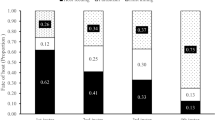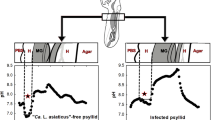Abstract
MANY insect parasitoids are capable of distinguishing whether their prospective hosts are healthy or whether the hosts already contain a parasitoid larva of the same or a different species. In many cases discrimination is made possible by an odour or chemical trace left on the surface of the host by the initial parasitoid1, or else gross. physical changes in the host such as desiccation or immobility2. Some endoparasitic ichneumonids can detect a parasitized host solely by penetration with the ovipositor3–5, but nothing is known of the chemical stimuli, in the haemolymph which may elicit this discrimination.
This is a preview of subscription content, access via your institution
Access options
Subscribe to this journal
Receive 51 print issues and online access
$199.00 per year
only $3.90 per issue
Buy this article
- Purchase on Springer Link
- Instant access to full article PDF
Prices may be subject to local taxes which are calculated during checkout
Similar content being viewed by others
References
Salt, G., Proc. Roy. Soc., B, 122, 57 (1937).
Ullyett, G. C., Proc. Roy. Soc., B, 120, 253 (1936).
Fisher, R. C., Canad. J. Zool., 37, 429 (1959).
Dethier, V. G., J. Exp. Zool., 105, 199 (1947).
Jackson, D. J., Trans. Roy. Entomol. Soc., 118 (2), 23 (1966).
Benz, G., in Insect Pathology (edit. by Steinhaus, E. A.), 1, 299 (Academic Press, New York, 1963).
Shotwell, O. L., Bennett, G. A., Hall, H. H., Stubblefield, R. D., Peters, J. E., van Etten, C. H., and Jackson, R. W., J. Insect Physiol., 11, 671 (1965).
Ishimori, N., and Muto, M., J. Seric. Sci. Tokyo, 20, 128 (1951).
Van der Geest, L. P. S., and Craig, R., J. Invert. Path., 9, 43 (1967).
Ganesalingam, V. K., thesis, University of London (1969).
Pratt, J. J., Ann. Ent. Soc. Amer., 43, 573 (1950).
Auclair, J. L., and Maltais, J. B., Canad. Ent., 86, 377 (1954).
Kohn, J., Clinica. Chim. Acta, 2, 297 (1957).
Sodeman, W. A., J. Parasitol., 54, 775 (1968).
Arthur, A. P., Hegdekar, B. M., and Rollins, L., Nature, 223, 966 (1969).
Townes, H., Momoi, S., and Townes, M., Ann Arbor Mem. Ann. Ent. Inst., No. 5 (1965).
Author information
Authors and Affiliations
Rights and permissions
About this article
Cite this article
FISHER, R., GANESALINGAM, V. Changes in the Composition of Host Haemolymph after Attack by an Insect Parasitoid. Nature 227, 191–192 (1970). https://doi.org/10.1038/227191a0
Received:
Revised:
Issue Date:
DOI: https://doi.org/10.1038/227191a0
This article is cited by
-
Parasite reliance on its host gut microbiota for nutrition and survival
The ISME Journal (2022)
-
Host-Induced Plant Volatiles Mediate Ability of the Parasitoid Microplitis croceipes to Discriminate Between Unparasitized and Parasitized Heliothis virescens Larvae and Avoid Superparasitism
Journal of Chemical Ecology (2020)
-
Inter- and intra-specific host discrimination in gregarious and solitary endoparasitoid wasps
BioControl (2013)
-
10.1007/BF00221254
CrossRef Listing of Deleted DOIs (2011)
-
10.1007/BF00295253
CrossRef Listing of Deleted DOIs (2011)
Comments
By submitting a comment you agree to abide by our Terms and Community Guidelines. If you find something abusive or that does not comply with our terms or guidelines please flag it as inappropriate.



